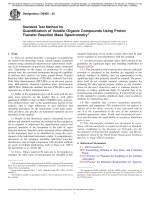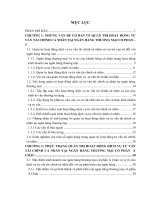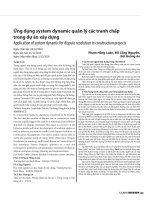Ebook Managing facilitated processes: A guide for consultants, facilitators, managers, trainers, event planners, and educators - Part 1
Bạn đang xem bản rút gọn của tài liệu. Xem và tải ngay bản đầy đủ của tài liệu tại đây (745.4 KB, 58 trang )
Managing
Facilitated Processes
A Guide for Consultants, Facilitators,
Managers, Trainers, Event Planners,
and Educators
Dorothy Strachan and Marian Pitters
More Praise for Managing Facilitated Processes
“This comprehensive guide is an outstanding resource and learning tool for event
planners, administrators, and consultants!”
—Barbara Metcalfe, executive assistant, Ottawa, Canada
“If you’ve ever participated in a session facilitated by Dorothy Strachan, you have
witnessed the effectiveness with which she practices her art. Managing Facilitated
Processes captures the essence of this art in a practical, step-by-step fashion that I’ve
used for facilitating management sessions as well as meetings of volunteer little
league baseball coaches. It works!”
—George A. Herrera, vice president, donor services,
Musculoskeletal Transplant Foundation, New Jersey, USA
“As a consultant, Marian Pitters demands a lot and delivers a lot. This is clear in
Managing Facilitated Processes, which is filled with practical examples from a broad
range of fields, up-to-date technologies, and approaches. Whether you are doing it
yourself or hiring an expert, this book is easy to follow and a great investment!”
—Lise R. Talbot, professeure titulaire, Université de Sherbrooke, Quebec, Canada
“Strachan and Pitters leave no detail unexamined in their book, Managing Facilitated
Processes. The practical formats, checklists, and examples alone make this book a
must-have for anyone planning, organizing, or facilitating an event of any kind.”
—Ann Epps, founder, former board member, and long-time
group facilitator, International Association of Facilitators,
Colorado, USA, and Kuala Lumpur, Malaysia
“The brilliance of this book lies in the scope of its advice, the abundance of useful
tools, and the practicality of its examples. Everything you need to know to successfully manage facilitated processes is here. I wish I had this book twenty years ago
when I began consulting!”
—Helen Lampert, certified management consultant (CMC),
and partner, The WISDOM™ Practice, Toronto, Canada
“If, like me, you are one of those people who struggle with the details when planning
a facilitated process—keep this book close at hand! It provides a wealth of tips and
forget-me-not tools that will guide your preparation, keep you on track, and ensure
your success.”
—Christine Partridge, facilitator, Kinharvie Institute of Facilitation, Glasgow, Scotland
“Facilitation has become a core competency for team leaders, managers, and
executives in all sectors worldwide. Strachan and Pitters have created a gold
mine of ideas, tools, and checklists to support those responsible for managing
successful facilitated processes.”
—Susan Ward, IAF certified TM professional facilitator (CPF),
Abu Dhabi, United Arab Emirates
“Based on many years of professional experience, Strachan and Pitters provide a
practical reflection on what works and what doesn’t when it comes to process
facilitation. An explicit, how-to guide for both rookie and veteran facilitators alike.
—Emily Gruenwoldt Carkner, founder and national co-chair,
Emerging Health Leaders, Ottawa, Canada
“Managing Facilitated Processes is a great companion to Dorothy Strachan’s previous
two books on facilitation. This refined perspective on the complex process of facilitation management can only be done by an author who has high professional
standards coupled with extensive and rich experience.”
—Branka Legetic, regional adviser, Pan American Health Organization,
Central and South America and the Caribbean
“Managing Facilitated Processes is a basic reference book for consultants. It provides
a comprehensive collection of tools, approaches, and processes that will enable
any consultant to navigate a productive pathway through unique and challenging
situations.”
—Richard Tiberius, director and professor, educational development office,
Miller School of Medicine, University of Miami, Florida, USA
“A rich, must-have resource for those who engage in process design and facilitation
or who hire others for this work. This desktop handbook contains a wealth of
practical instruction and tools, reflecting the extensive experience and wisdom
of the authors.”
—Mary Ellen Jeans, president and CEO, Associated Medical Services, Toronto, Canada
Managing
Facilitated
Processes
A Guide for Consultants,
Facilitators, Managers, Trainers,
Event Planners, and Educators
Dorothy Strachan and Marian Pitters
Copyright © 2009 by Dorothy Strachan and Marian Pitters. All rights reserved.
Published by Jossey-Bass
A Wiley Imprint
989 Market Street, San Francisco, CA 94103-1741—www.josseybass.com
Illustrations: Albert Prisner, Ottawa, Ontario, Canada
Research: Karen Metcalfe, Windsor, Ontario, Canada
No part of this publication may be reproduced, stored in a retrieval system, or transmitted in any form or
by any means, electronic, mechanical, photocopying, recording, scanning, or otherwise, except as permitted
under Section 107 or 108 of the 1976 United States Copyright Act, without either the prior written permission
of the publisher, or authorization through payment of the appropriate per-copy fee to the Copyright
Clearance Center, Inc., 222 Rosewood Drive, Danvers, MA 01923, 978-750-8400, fax 978-646-8600, or on the
Web at www.copyright.com. Requests to the publisher for permission should be addressed to the Permissions
Department, John Wiley & Sons, Inc., 111 River Street, Hoboken, NJ 07030, 201-748-6011, fax 201-748-6008,
or online at www.wiley.com/go/permissions.
Readers should be aware that Internet Web sites offered as citations and/or sources for further information
may have changed or disappeared between the time this was written and when it is read.
Limit of Liability/Disclaimer of Warranty: While the publisher and author have used their best efforts in
preparing this book, they make no representations or warranties with respect to the accuracy or completeness of the contents of this book and specifically disclaim any implied warranties of merchantability or fitness for a particular purpose. No warranty may be created or extended by sales representatives or written
sales materials. The advice and strategies contained herein may not be suitable for your situation. You
should consult with a professional where appropriate. Neither the publisher nor author shall be liable for
any loss of profit or any other commercial damages, including but not limited to special, incidental, consequential, or other damages.
Jossey-Bass books and products are available through most bookstores. To contact Jossey-Bass directly call
our Customer Care Department within the U.S. at 800-956-7739, outside the U.S. at 317-572-3986, or fax
317-572-4002.
Jossey-Bass also publishes its books in a variety of electronic formats. Some content that appears in print
may not be available in electronic books.
Library of Congress Cataloging-in-Publication Data
Strachan, Dorothy.
Managing facilitated processes: a guide for consultants, facilitators, managers, trainers, event planners,
and educators / Dorothy Strachan and Marian Pitters.
p. cm. —(The Jossey-Bass business & management series)
Includes bibliographical references.
ISBN 978-0-470-18267-3 (pbk.)
1. Group facilitation. 2. Consultants. 3. Planning. I. Pitters, Marian II. Title.
HM751.S772 2009
001—dc22
2008051603
Printed in the United States of America
first edition
PB Printing 10 9 8 7 6 5 4 3 2 1
The Jossey-Bass
Business & Management Series
Previous Books by Dorothy Strachan
Making Questions Work: A Guide to What and How to Ask for
Facilitators, Consultants, Managers, Coaches, and Educators
Process Design: Making It Work—A Practical Guide to What to Do
When and How for Facilitators, Consultants, Managers, and Coaches
(with Paul Tomlinson)
Contents
Examples, Exhibits, and Tables
Web Contents
Acknowledgments
The Authors
Introduction
About This Book
A Quick Lookup Resource
PART 1
1
xi
xiii
xv
xvii
xix
xix
xxi
FROM CONTACT TO CONTRACT
1
Initial Contact
Completing a Preliminary Screen
3
5
Coordinates: Date(s) and Location • Purpose, Objectives,
and Deliverables • Process Leadership • Eighteen Types
of Processes
2
Decision Making After the Screen
Communicating a Decision
11
13
Building Agreements That Work
Types of Agreements
Drafting Agreements
Agreements in Action: Four Maxims
15
16
16
18
1. Don’t Start Work Without an Agreement • 2. Bring Fresh
Eyes to Your Experience • 3. When in Doubt, Write It Out
• 4. Cock-ups Are Collaborative
Work Plans and Cost Estimates
21
Developing Work Plans • Dealing with Pricing Perils
Acting on Values
24
vii
viii
Contents
PART 2
3
APPROACH AND STYLE
33
Approach
Integrated
Customized
35
35
36
Outcomes • People • Group Development • Ethnocultural
Considerations • Literacy • Organizational Culture
Systematic
38
Completing a Process Management Prompter • Accountability
The Approach in Action: Integrated, Customized, Systematic
4
PART 3
5
45
Style
High-Tech Teddy
Controlling Caroline
Loosey-Goosey Lucy
Overconsulting Oliver
Anxious-to-Please Annie
Bureaucratic Bill
Optimizing Management Styles
51
52
53
54
55
56
57
57
MANAGEMENT x 5: PARTICIPANTS, SPEAKERS, LOGISTICS,
DOCUMENTS, FEEDBACK
59
Participants
Clarify the Rationale for Participation
Monitor the Mix and Number of Participants
61
62
66
Consider Participant Types • Gatekeep Participant Numbers
• Maintain a Participant Database
Create the Invitations
73
Persuade • Inform • Engage • Determine the Focus
• Obtain Input and Feedback • Write the Confirmation Letter
6
Speakers
Speaker Management
95
95
Clarify Requirements • Create Invitations • Confirm Expectations
Presentation Guidelines
104
Opening Remarks • Speaker Introductions and Acknowledgments
• Presentations by Experts • Presentations by Panels • Closing
Remarks
7
Logistics
Select and Set Up the Site
119
120
Venue • Layout • Health, Safety, and Security • Technical and
Audiovisual Support
Enable Participant Engagement
Accommodating Differences • Identification • Accessibility
132
Contents
Mobilize Yourself
ix
137
Professional Supplies • Travel Arrangements
• Personal Amenities
Love those Logistical Letdowns!
8
Documents
Match the Documents to the Process
Produce the Documents
140
143
144
145
Make Documents Easy to Use • Design Attractive Formats
• Customize Documents
9
Feedback
Review Feedback Approach and Tools
Finalize and Produce Feedback Tools
151
151
157
Construction • Look, Feel, and Sound
Sample Feedback Tools
10
159
Endings and Beginnings
For the Session
For Yourself
169
169
171
References
173
Examples, Exhibits, and Tables
Examples
1.1
When the Client’s Answer Is Yes
13
1.2
When Your Answer Is No
14
2.1
Informal Letter of Agreement
25
2.2
Memo of Understanding
26
2.3
Formal Contract for a Complex, Multiphase Project
with a Large Organization
29
5.1
Finding Participants for a Restricted Session
65
5.2
Upstream Prevention
81
5.3
Writing Invitations for Specific Situations
85
5.4
Six Invitations
89
6.1
Informal Speaker Invitation
99
6.2
Speaker Confirmation Letter
102
6.3
Outline for Opening Remarks
110
6.4
Outline for Closing Remarks
116
8.1
Matching Documents to a Process
146
1.1
The Preliminary Screen
3.1
Process Management Prompter
40
5.1
Participant Database Checklist
74
5.2
Participant Database Information Form
75
5.3
Invitations and Announcements Checklist
83
Exhibits
4
xi
xii
Examples, Exhibits, and Tables
5.4
Feedback on Draft Invitation
88
5.5
Confirmation Letter Checklist
94
6.1
Identify Speaker Functions
96
6.2
Speaker Confirmation Letter Checklist
100
7.1
Logistics Checklist
129
7.2
Enabling Participant Engagement Checklist
136
7.3
“Mobilizing Yourself” Logistics Checklist
138
9.1
Feedback Map
153
9.2
Form for Reviewing Feedback Tools
154
9.3
Interim Participant Feedback Form: Version 1
159
9.4
Interim Participant Feedback Form: Version 2
160
9.5
Summative Participant Feedback Form: Version 1
161
9.6
Summative Participant Feedback Form: Version 2
162
9.7
Summative Participant Feedback Form: Version 3
163
9.8
Summative Participant Feedback Form: Version 4
164
9.9
Workshop Manager Feedback Form
165
9.10
Workshop Management Log
166
9.11
Client or Stakeholder Feedback Form
167
Tables
1.1
Types of Facilitated Processes
8
2.1
Types of Agreements
17
5.1
Participation: Five Options
62
7.1
Room Layout Options
124
Web Contents
FREE
Premium Content
Pr
This book includes premium content that can be
accessed from our Web site when you register at
www.josseybass.com/go/dorothystrachan
using the password professional.
Exhibits
1.1
The Preliminary Screen
3.1
Process Management Prompter
5.1
Participant Database Checklist
5.2
Participant Database Information Form
5.3
Invitations and Announcements Checklist
5.4
Feedback on Draft Invitation
5.5
Confirmation Letter Checklist
6.1
Identify Speaker Functions
6.2
Speaker Confirmation Letter Checklist
6.3
Speaker Invitation Checklist
7.1
Logistics Checklist
7.2
Enabling Participant Engagement Checklist
7.3
“Mobilizing Yourself” Logistics Checklist
7.4
Participant Physical Accessibility Map
8.1
Matching Documents to a Process
9.1
Feedback Map
9.2
Form for Reviewing Feedback Tools
9.3
Interim Participant Feedback Form: Version 1
9.4
Interim Participant Feedback Form: Version 2
9.5
Summative Participant Feedback Form: Version 1
9.6
Summative Participant Feedback Form: Version 2
xiii
xiv
Web Contents
9.7
Summative Participant Feedback: Form: Version 3
9.8
Summative Participant Feedback Form: Version 4
9.9
Workshop Manager Feedback Form
9.10
Workshop Management Log
9.11
Client or Stakeholder Feedback Form
Acknowledgments
WE OFFER A SINCERE THANK-YOU to the clients, participants, and stakeholders in countless facilitated processes who have taught us that what
many consider to be the smaller and less significant decisions are in fact
some of the most important decisions that we can make.
Several colleagues provided thoughtful reviews of an earlier version of
this book. Their rich experience and insightful feedback also contributed to
the quality of this publication.
Writing is a commitment that authors, their families, and their friends
take on together. We appreciate the patience and support that those close to
us have shown during our frequent absences in body, mind, and spirit over
the past two years.
xv
The Authors
DOROTHY STRACHAN AND MARIAN PITTERS have been designing, facilitating, and managing a broad range of processes for many years.
Dorothy has been a professional facilitator since 1974. Her practice
addresses three main areas: process design and facilitation, organizational
interventions such as strategic planning and team development, and the
creation and facilitation of customized workshops and learning programs.
She is the author of publications in leadership development, facilitation,
strategic planning, and effective coaching in high-performance sport.
Dorothy is a partner in Strachan-Tomlinson, a process management firm
based in Canada with a special interest in the health sector. She may be contacted at www.strachan-tomlinson.com.
Marian has worked as a process consultant, facilitator, and writer for
organizations for over twenty-five years. She enjoys this depth and breadth
of consulting experience in both the not-for-profit and private sectors in
areas such as financial services, community and social services, health,
insurance, government, retail, manufacturing, and education. In addition
to her practical experience, Marian has a doctorate in adult education and
is particularly attracted to integrating theory and practice in her work with
clients. She may be contacted at www.pittersassociates.ca.
Managing Facilitated Processes is a companion book to two previous
Jossey-Bass business publications: Process Design: Making It Work, by
Dorothy Strachan and Paul Tomlinson (2008), and Making Questions Work,
by Dorothy Strachan (2007). All three resources are practical desktop tools
incorporating the extensive experience of the authors.
xvii
Introduction
If you set up and manage workshops, meetings, and other types of facilitated sessions, this book is for you. And you are in good company because
managing facilitated processes is becoming an essential skill for project
managers and leaders, professional facilitators, management consultants
and committee chairs, teachers and trainers, community organizers,
lawyers, physicians, accountants, and human resource professionals, as well
as mediators, negotiators, social workers, and counselors.
The list is long because more and more of the work of organizations is
being done in facilitated group sessions—both virtual and face to face—
where success requires sensitive and thoughtful attention to setup and
management.
As designers, facilitators, and managers of these sessions, we have spent
a great deal of time thinking about what makes them successful. One thing
we know for sure: participants are more likely to have great experiences in
facilitated processes when careful attention is given to all the details influencing the activities, technology, and settings that make things run smoothly.
This includes making thoughtful decisions about how participants are
selected and invited, what space is appropriate (virtual or face to face), how
presentations are aligned with objectives, how handouts and worksheets are
used, what types of reports are written, and what questions are selected for
feedback purposes.
About This Book
This easy-access resource has a strong focus on the practical.
Each chapter includes management guidelines and insights, lessons
learned, strategies for difficult situations, and examples based on the
xix
xx
Introduction
authors’ many years of experience, as well as many exhibits containing
prompters, checklists, and other tools. Electronic, adaptable, and expandable versions of these exhibits are provided on the Jossey-Bass Web site, at
www.josseybass.com/go/dorothystrachan. We’ve used a Web icon in this
book to identify the exhibits available on-line.
The nine chapters of Managing Facilitated Processes are divided into three
parts:
1. “From Contact to Contract”
2. “Approach and Style”
3. “Management x 5: Participants, Speakers, Logistics, Documents,
Feedback”
Part One describes how to build customized agreements, from the initial contact with a client (Chapter One) to the confirmation of how everyone involved will work together throughout a process (Chapter Two).
Chapter Two also profiles eighteen types of processes, their deliverables,
and their unique features.
Part Two outlines two areas in process management: approach and
style. Chapter Three explores the need for an approach that is integrated,
customized, and systematic. It includes a forget-me-not prompter that helps
you to scope a session you are managing and to diagnose challenges and
opportunities for five key elements: participants, speakers, logistics, documents, and feedback. Chapter Four discusses the need for a management
style that builds on strengths and mitigates weaknesses in support of
healthy relationships and productivity.
Part Three offers a comprehensive look at managing the five key session elements: participants, speakers, logistics, documents, and feedback.
A full chapter is devoted to each area, offering practice guidelines, examples, and time-saving tools that you can customize to your situations.
When a company or client holds a workshop, retreat, conference, or
other similar activity, more often than not only one or two people are
responsible for designing, facilitating, and managing the entire event. Our
focus in this book is on guiding people in any organizational role to manage meetings, workshops, and other facilitated processes successfully by
attending to these five elements.
Finally, Chapter Ten, “Endings and Beginnings,” emphasizes the importance of looking past what happens before and during a session and toward
what happens after the last person leaves. This is the time when follow-up
activities take place and session conclusions and decisions are put into practice and begin to show an impact.
Introduction
xxi
Although each chapter is designed to stand on its own, the chapters are
also interrelated. For example, the decisions about participants and stakeholders described in Chapter Five will have an impact on the decisions
about location and setup discussed in Chapter Seven, which in turn will
support the decisions about speaker requirements discussed in Chapter Six.
Investing in due diligence at the front end of a process enables the
process designer, facilitator, and manager to understand the people, the situation, and its challenges so that a customized environment will support
the achievement of expected outcomes at the back end. This book takes a
practical approach to this due diligence: don’t manage a process without it.
A Quick Lookup Resource
The table of contents for this book is also the index. Skim the headings in
the Contents to search for the topic you want. On the outer edge of this
book, we’ve used gray tabs to help you find each chapter quickly. Hold the
book with the front cover face down. On the back cover, put your thumb
on the gray tab for the chapter you want. Then slide your thumb down the
edges of the pages until you come to the gray stripe that corresponds to the
tab on the back of the book.
Managing
Facilitated
Processes




